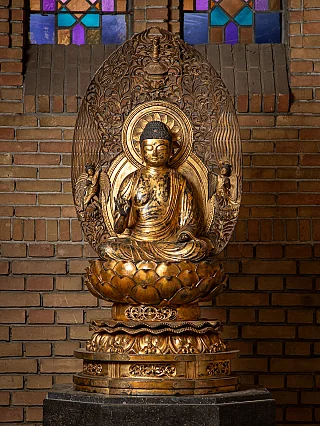Amida Buddha
Author : Peter Vredeveld

Pure Land Buddhism was popularized only after the end of the 10th century in Japan. This sector of Mahayana Buddhism primarily focuses on the teachings of Amida Buddha (known in Japan) or Amitabha Buddha (known in southeast Asia).
View our Amida Buddha statues in gallery
As written in Pure Land Buddhism sutra, Amida Buddha was bodhisattva Dharma Kara in his past life. Dharma Kara was a king who was introduced to Buddhism by Lokesvararaja Buddha. Learning the principles and knowledge from Lokesvararaja Buddha, Dharma Kara renounced his throne and decided to follow the path of Buddha. Later, after becoming Buddha, he possessed a Pure Land (western paradise, or Shukhavati Bhuwan). Amida Buddha has described clearly this pure land (nature, how one can be born in this paradise) in his 48 vows. He promised salvation for those who recited his sutra, accumulated merits through meditation, and assured rebirth in his paradise.
The iconography of Amida Buddha
Amida Buddha is often depicted in two postures - seating and standing. While depicted in a sitting posture, Amida Buddha is displayed with meditation mudra. Both of the hands gently folded over the lap with palms facing upward. In some instances, thumbs are raised and touched with one another. While depicted in standing posture, Amida Buddha is displayed with Dharma chakra mudra. Right hand raised with thumb and forefinger touched with one another and left arm extended downward with thumb and forefinger touched with one another.
Apart from gesture and posture, Amida Buddha is displayed with thick cheeks, wears a monastic robe, and semi-closed small eyes to align with the localized form of Japanese people.
Amida Buddha Statues in Japan

1. Kamakura Daibutsu at Kotoku-in temple

Amida Buddha statue of Kotoku-in temple was built in the 13th century with a height of 11.4 meters (statue only). This bronze statue is depicted in a sitting posture with a meditation mudra. A monastic robe covers the foot of the Buddha statue.
Initially, the statue was inside the temple hall, but as the temple buildings were destroyed multiple times by typhoons and tsunamis in the 14th and 15th centuries, the statue is now in an open space.
2. Amida Buddha at Byodo-in temple

The Amida Buddha statue of the Byodo-in temple was built in the 11th century and is around 9 feet tall. This gold-leaf-covered statue is depicted in a sitting posture with a meditation mudra. A monastic robe covers the foot of the Buddha statue.
View all of our statues in our gallery
3. Ushiku Daibutsu

The Amida Buddha statue in Ushiku was built in the 20th century and is 120 meters high. The statue is one of the top five tallest statues in the world. This bronze statue wears a monastic robe and is depicted standing with a Dharma chakra mudra.
4. Ikko Sanzon Amida Buddha at Zenko Ji temple

The Amida Buddha statue located in Zenko Ji temple was crafted in India and brought to Japan in the 6th century. The original Buddha statue is hidden and needs to be shown to everyone. Hence, a replica of the Amida Buddha statue is constructed to display to the public once in the sixth year in the Gokaicho ceremony.
5. Takaoka Daibutsu

Amida Buddha Statue of Toyama City was originally constructed of wood in the 13th century. However, due to various natural calamities, it was severely affected multiple times. In the 20th century, Takaoka Daibutsu was re-erected as a copper statue with a height of 52 feet. The statue is depicted sitting on a lotus base with a meditation mudra. The Buddha wears a monastic robe and has a halo behind his head.
Share this page



















